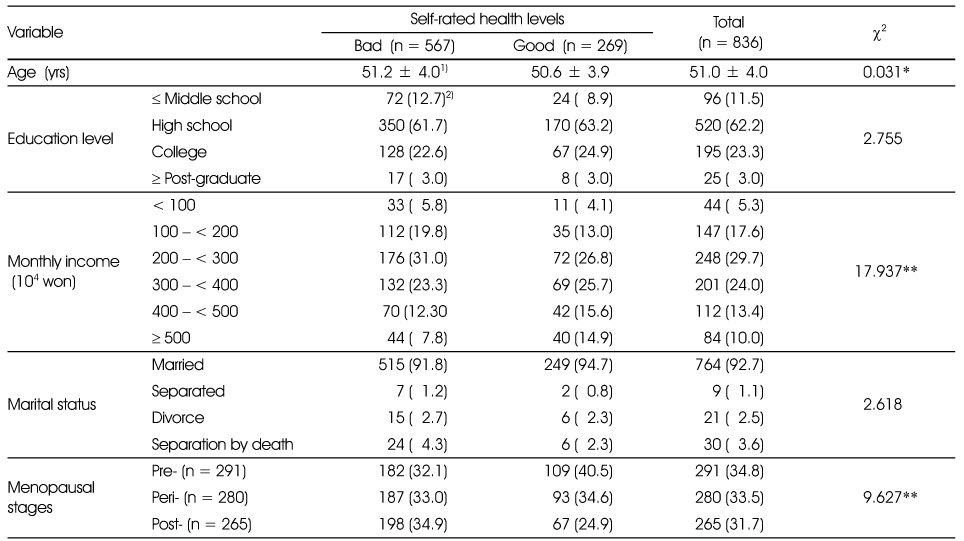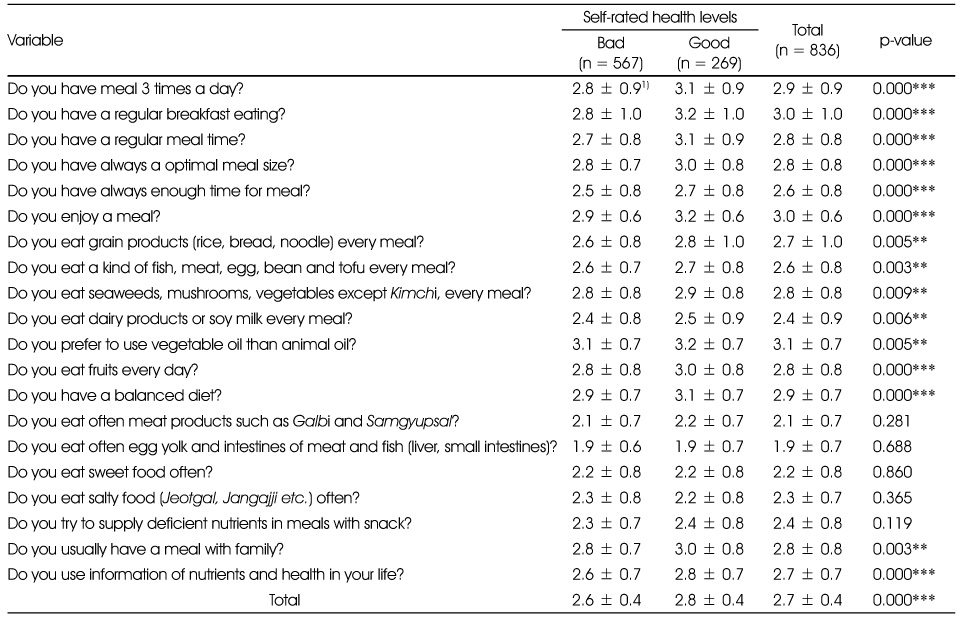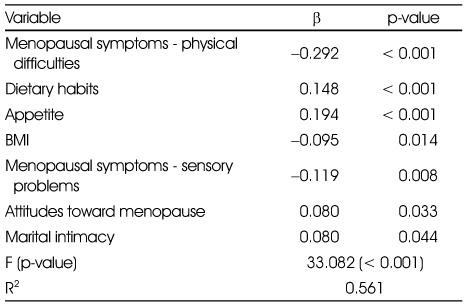Articles
- Page Path
- HOME > Korean J Community Nutr > Volume 17(3); 2012 > Article
-
Original Article
- The Related Factors Influencing on Self-rated Health Level of Middle-aged Women
- Hyejin Lee, Kyung-Hea Lee, Eunkyung Kim, Mi-Jung Kim, Suk-Man Hwang
-
Korean Journal of Community Nutrition 2012;17(3):290-301.
DOI: https://doi.org/10.5720/kjcn.2012.17.3.290
Published online: June 30, 2012
Department of Food and Nutrition, Changwon National University, Gyeongnam, Korea
1Department of Child and Family, Changwon National University, Gyeongnam, Korea.
2Department of Food and Nutrition, Silla University, Busan, Korea.
3Department of Sociology, Changwon National University, Gyeongnam, Korea.
- Corresponding author: Kyung-Hea Lee, Department of Food and Nutrition, Changwon National University, 9 Sarimdong, Uichanggu, Changwon, Gyeongnam 641-773, Korea. Tel: (055) 213-3514, Fax: (055) 281-7480, khl@changwon.ac.kr
Copyright © 2012 The Korean Society of Community Nutrition
- 876 Views
- 0 Download
- 17 Crossref
Abstract
- This survey of 836 midlife women (51.0 ± 4.0 yrs) was undertaken by exclusively a face to face interview by well-trained interviewers guarantying data collection of higher quality. This survey data was analyzed using the SPSS program. The main purpose of this study was to describe the factors affecting self-rated health status, including dietary habits and physical · mental · social factors. In the self-rated health status of a 'good' group, age was lower (p < 0.05), monthly income was higher (p < 0.01), dietary habits score (p < 0.001) and appetite (p < 0.001) and the degree of movement (p < 0.001) and life satisfaction (p < 0.001), marital intimacy (p < 0.001) and relationship satisfaction with their children (p < 0.001) were significantly higher than the 'bad' group. The level of depression (p < 0.001) and severe feeling of menopausal symptoms (p < 0.001) were significantly higher in the 'poor' group. The results of correlation analysis demonstrated that educational level (r = 0.069, p < 0.05),income (r = 0.157, p < 0.001), eating habits (r = 0.235, p < 0.001), appetite (r = 0.263, p < 0.001), life satisfaction (r = 0.197, p < 0.001), marital intimacy (r = 0.167, p < 0.001), child relationship satisfaction (r = 0.149, p < 0.001), positive attitude toward menopause (r = 0.070, p < 0.05) showed a positive correlation, but depression (r = -0.122, p < 0.001) and menopausal symptoms (r = -0.292, p < 0.001) showed a negative association with self-rated health status. The predictable factors affecting the self-rated health status of middle-aged women were examined by multiple regression analysis. The 'menopausal symptoms - physical discomfort' was the most important variables followed by the 'appetite', 'eating habits', 'menopause symptoms - sensory problems', 'BMI', 'positive attitude toward menopause' and 'high marital intimacy'. These results showed that the 'appetite' and 'eating habits' are important factors affecting the self-rated health status. Therefore, a program of dietary education must be considered for the effective health education and counseling of middle-aged women.
-
This study was financially supported by the 2009 research fund(09-41) from Management Center for Health Promotion in Republic of Korea and by Changwon National University in 2011.
NOTES
- 1. American Dietetic Association. Position of the American dietetic association: food fortification and dietary supplements. J Am Diet Assoc. 2001; 101(1): 115-125.PubMed
- 2. Appels A, Bosma H, Grabauskas V, Gostautas A, Strumans F. Self-rated health and mortality in a Lithuanian and Dutch population. Soc Sci Med. 1996; 42: 681-689.PubMed
- 3. Baek SS. An analysis of the relationship of menopausal symptoms of midwife women between urban area. J Korean Acad Womens Health Nurs. 1998; 4(3): 332-347.
- 4. Bailis DS, Segall A, Chipperfield JG. Two views of self-rated general health status. Soc Sci Med. 2003; 56: 203-217.ArticlePubMed
- 5. Bowling A. Measuring Disease. 2001; 2nd edition. Buckingham · Philadelphia: Open University; 2-8.
- 6. Chang HK, Han YB. A study on the climacteric symptoms and dietary patterns in middle-aged women. J Korean Home Econ Assoc. 2002; 40(1): 125-134.
- 7. Choi IR. Anger expression type and mental health in middle aged women. J Korean Acad Nurs. 2009; 39(4): 602-612.ArticlePubMed
- 8. Feeny D, Torrance GW, Furlong W, Goldsmith C. Health utilities index mark 3: utility scores for 74 prevalent health states. Quality Life Res. 1995; 4(5): 424.
- 9. Fylkesnes K, Forde OH. The tromoso study; predictors of self-evaluated health-Has society adopted the expanded health concept? Soc Sci Med. 1991; 32(2): 141-146.PubMed
- 10. Gander J, Lee D, Sui X, Hbert JR, Hooker SP. Self-rated health status and cardiorespiratory fitness as predictors of mortality in men. Br J Sports Med. 2011; 45(14): 1095-1100.ArticlePubMed
- 11. Goodwin DK, Knol LL, Eddy JM, Fitzhugh EC, Kendrick OW, Donahue RE. The relationship between self-rated health status and the overall quality of dietary intake of US adolescents. J Am Diet Assoc. 2006; 106: 1450-1453.ArticlePubMed
- 12. Grant MD, Piotrowski ZH, Chappell R. Self-related health and survival in the logitudinal study of aging, 1984-1986. J Clin Epidemiol. 1995; 48(3): 375-387.PubMed
- 13. Hilditch JR, Lewis J, Peter A, van Maris B, Ross A, Franssend E, Guyatt GH, Norton PG, Dunn E. A menopause-specific quality of life questionnaire: Development and psychometric properties. Maturitas. 1996; 24(3): 161-175.ArticlePubMed
- 14. Idler EL, Benyamini Y. Self-rated health and mortality - A review of twenty-seven community studies. J Health Soc Behav. 1997; 38: 21-37.ArticlePubMed
- 15. Kim AK. Yangsaeng and health related quality of life (HRQOL) in middle aged women. Korean J Women Health Nurs. 2010; 16(3): 297-306.ArticlePubMed
- 16. Kim HC, Kim MR. A study on health-functional foods intake pattern of consumers in Busan and Gyeongnam area. Korean J Hum Ecol. 2006; 15(2): 341-352.
- 17. Kim HJ. Comparison of the level of marital intimacy according to the level of stress among middle-aged women. J Korean Soc Matern Child Health. 2001; 5(1): 123-136.
- 18. Kim HS, Yoon KH, Lee MJ, Seo BH. Intake and awareness of the functional health food among housewives in Cheongju area. J Hum Ecol. 2005; 9(2): 179-196.
- 19. Kim MY, Han SY, Jeong JH, Kim SH, Lee JK, Park ES, Zhang XH, Seo JS. Effectiveness of nutrition-exercise education program on weight control of adult women. Korean J Community Nutr. 2009; 14(2): 168-174.
- 20. Koo NS, Park JY. Health states and health-related lifestyle of middle-aged people in Daejon. Korean J Diet Cult. 2001; 16(2): 137-146.
- 21. Kwak EK. The middle life women's menopause knowledge, attitude, symptom and management. 2006; Graduate School of KonKuk University; 7-16 MS thesis.
- 22. Lee JY. A study on wives' marital satisfaction and related variables. J Korean Home Econ Assoc. 1987; 25(1): 105-119.
- 23. Lee JY, Chae SK, Kim KD. The perceptions and purchase intentions of health food consumers. Korean J Food Preserv. 2011; 18(1): 103-110.Article
- 24. Lee PS. Correlational study among anger, perceived stress and mental health status in middle aged women. J Korean Acad Nurs. 2003; 33(6): 856-864.ArticlePDF
- 25. Lee YR, Kim MJ. A transition of health habits and self-rated health status of women aged in early adulthood. J Korean Acad Public Health Nurs. 2009; 23(2): 199-206.
- 26. Lobo RA, Whitehead MI. Is low-dose hormone replacement therapy for postmenopausal women efficacious and desirable? Climacteric. 2001; 4(2): 110-119.ArticlePubMed
- 27. Miilunpalo S, Vuori I, Pasanen M, Urponen H. Self-rated health status as a health measure: the predictive value of self-reported health status on the use of physician services and on mortality in the working-age population. J Clin Epidemiol. 1997; 50(5): 517-528.ArticlePubMed
- 28. Mishra N, Mishra VN, Devanshi . Exercise beyond menopause: dos and dont's. J Midlife Health. 2011; 2(2): 51-56.ArticlePubMedPMC
- 29. Nam BH, Lee SW. Testing the validity of the Korean SF-36 health survey. J Korean Soc Health Stat. 2003; 28(2): 3-24.
- 30. Oh YH, Bae HO, Kim YS. A study on physical and mental function affecting self-perceived health of older persons in Korea. J Korean Gerontol Soc. 2006; 26(3): 461-476.
- 31. Pakzad K, Boucher BA, Kreiger N, Cotterchio M. The use of herbal and other non-vitamin, non-mineral supplements among pre- and post-menopausal women in Ontario. Can J Public Health. 2007; 98(5): 383-388.ArticlePubMedPMCPDF
- 32. Park GJ. A structure model for depression in middle-aged women. 1999; The graduate school of Ewha women's University; 44-45. 100 MS thesis.
- 33. Park GJ, Lee KH. A structural model for depression in middle-aged women. Korean J Women Health Nurs. 2002; 8(1): 69-84.ArticlePDF
- 34. Park HS, Lee YM, Cho GY. A study on climacteric symptoms, knowledge of menopause, menopausal management in middle-aged women. Korean J Women Health Nurs. 2002; 8(4): 521-528.ArticlePDF
- 35. Pyun JS, Kim MJ, Lee KH. Climacteric and menopausal women's beliefs on daily meals and food supplements-a focus group interview study-. Korean J Community Nutr. 2011; 16(2): 239-252.Article
- 36. Schleifer SJ, Keller SE, Meyerson AT, Raskin MJ, Davis L, Stein M. Lymphocyte fanction in major depressive disorder. Arch Gen Psychiatry. 1984; 41: 484-486.ArticlePubMed
- 37. Seidell JC, Bakx KC, Deurenberg P. The relation between overweight and subjective health according to age, social class, slimming behavior and smoking habits in Dutch adults. Am J Public Health. 1986; 76(12): 1410-1415.ArticlePubMedPMC
- 38. Shin JM. An analysis of intake of health foods and supplements and its associated factors in middle · old aged adults living in Seoul and Kyon-gi region. 2002; Graduate School of Yonsei University; 23-42 MS thesis.
- 39. Smith EL, Reddan W, Smith DE. Physical activity and calcium modalties for bone mineral increase in aged women. Med Sci Sports Exerc. 1981; 13(1): 60-64.PubMed
- 40. Song AR. Health factors related to management of menopause among climacteric women. Korean J Women Health Nurs. 2005; 11(1): 12-19.ArticlePDF
- 41. Sowers M, Zheng H, Tomey K, Karvonen-Gutierrex C, Jannausch M, Li X, Yosef M, Symons J. Changes in body composition in women over six years at midlife: ovarian and chronological aging. J Clin Endocrinol Metab. 2007; 92(3): 895-901.ArticlePubMed
- 42. Statistics Canada. Indicators of well-being in Canada. Human resources and skills development Canada. 2012; cited 2012 March 10. Available from http://www4.hrsdc.gc.ca/c.4nt.2nt@-eng.jsp?cid=14.
- 43. Svedberg P, Bardage C, Sandin S, Pedersen NL. A prospective study of health, life-style and psychosocial predictors of self-rated health. Eur J epidemiol. 2006; 21: 767-776.ArticlePubMedPDF
- 44. Ware JE. Scales for measuring general health perceptions. Health Serv Res. 1976; 11(4): 396-415.PubMedPMC
- 45. Ware JE Jr. Standards for validating health measures: definition and content. J Chronic Dis. 1987; 40(6): 473-480.ArticlePubMed
- 46. Ware JE, Sherboume CD. The MOS 36-Item short-form health survey (SF-36). Medical Care. 1992; 30(6): 473-483.ArticlePubMed
- 47. Yang JH. A study on health behavior experience of middle-aged women in rural area. J Korean Acad Nurs. 2002; 32(5): 694-705.ArticlePDF
- 48. Yoo YJ, Hong WS, Youn SJ, Choi YS. The experience of health food usage for adults in Seoul. Korean J Soc Food Cookery Sci. 2002; 18(2): 136-146.
REFERENCES

1) 5-point Likert scale (1: Not at all, 2: Tend to not well, 3: Common, 4: Tend to well, 5: Very well)
2) 5-point Likert scale (1: Not at all, 2: Tend to not satisfied, 3: Common, 4: Tend to satisfied, 5: Very satisfied)
3) Values are Mean ± SD.
***: p < 0.001: Significantly different by Student's t-test
Figure & Data
REFERENCES
Citations

- Comparison of the health and dietary characteristics of postmenopausal middle-aged women according to subjective health perception: Based on the 8th (2019–2021) Korea National Health and Nutrition Examination Survey
Taegyeong Yeo, Chong-Su Kim, Yoon Jung Yang
Journal of Nutrition and Health.2025; 58(2): 200. CrossRef - Dietary Patterns and the Risk of Composite-Defined Osteoporosis in Pre- and Postmenopausal Women: A Prospective Cohort Study
Yejung Choi, Kyong Park
Nutrients.2025; 17(18): 2947. CrossRef - Self-rated health according to change of lifestyle after COVID-19: Differences between age groups
Dan Bi Lee, Jung Hyun Ahn, Jin Young Nam
Korean Journal of Health Education and Promotion.2022; 39(2): 1. CrossRef - Role Stress and Sense of Control Predict Using Food to Cope With Stress in Midlife Women
Dana R. Riedy, Ashley MacPherson, Natalie D. Dautovich
Journal of Aging and Health.2021; 33(9): 732. CrossRef - Food consumption frequency of Korean adults based on whether or not having chewing difficulty using 2013–2016 KNHANES by sex-stratified comparative analysis
Mi Jeong Kim
Nutrition Research and Practice.2020; 14(6): 637. CrossRef - Influence of Midlife Health Condition and Awareness of Successful Aging on Preparation for Old Age
Eun Ho Ha, Young Mi Lee
Korean Journal of Adult Nursing.2020; 32(5): 472. CrossRef - Analysis of Convergent Factors on Subjective Health Status of Patients with Depression
Myoung-Jin Kwon, Young-Ju Kim
Journal of Digital Convergence.2016; 14(6): 309. CrossRef - Health Status Assessment Tool Development based on Dietary Patterns in Middle-Aged Women
Hye-Jin Lee, Kyung-Hea Lee
Korean Journal of Community Nutrition.2016; 21(1): 37. CrossRef - Acculturation, Food Intake and Dietary Behaviors of Chinese College Students in Busan by Residential Period
Fangfang Song, Mi Jeong Kim
Journal of the East Asian Society of Dietary Life.2015; 25(4): 594. CrossRef - The Impacts of Dietary Habits on Self-perceived Health-related Physical Fitness in Middle-aged Women -Focused on Changwon Province-
Hye-Jin Lee, Kyung-Hea Lee
Journal of the Korean Society of Food Science and Nutrition.2014; 43(6): 916. CrossRef - Effects of Cultural Facilities and City Parks on the Regional Suicide Rates in Korea
Soo-Mi Cho, Hyung-Deok Shin
Journal of the Korea Academia-Industrial cooperation Society.2014; 15(8): 4874. CrossRef - A Study on Dietary Behaviors, Health-Related Lifestyle of Adult Visitors at Public Health Centers in Gyeonggi Urban Area
Jong-Sook Kwon, Kyungmin Kim, Hyun-Chang Seo, Yoonna Lee, Seunggeon Lim, Young-Sug Choi
Korean Journal of Community Nutrition.2013; 18(6): 611. CrossRef - A Study on the Knowledge, Attitudes, Cancer Preventive Dietary Behavior, and Lifestyles of Adults in the Jeonbuk Area
Jeongok Rho, Suyoun Choi
Korean Journal of Human Ecology.2013; 22(1): 201. CrossRef - Evaluation of Diet Quality according to Self-Rated Health Status of Korean Middle-Aged Women -Based on 2008~2009 Korean National Health and Nutrition Examination Survey-
Hye-Jin Lee, Kyung-Hea Lee
Journal of the Korean Society of Food Science and Nutrition.2013; 42(9): 1395. CrossRef - Anthropometric Index, Dietary Habits and Nutrient Intake of the Oldest-old Population Aged 95 and Over Living in Seoul
Chung Shil Kwak, Ji Hyun Cho, Miyong Yon, Sang Chul Park
Korean Journal of Community Nutrition.2012; 17(5): 603. CrossRef - Health-Related Factors Influencing the Quality of Life of Rural Elderly Subjects - Activities of Daily Living, Cognitive Functions, Prevalence of Chronic Diseases and Nutritional Assessment
Mee Sook Lee
Korean Journal of Community Nutrition.2012; 17(6): 772. CrossRef - Characteristics of the Health Factors in 45~60 Year Old Korean Women related to Menopausal Stages - Based on 2008~2009 Korean National Health and Nutrition Examination Survey -
Hye-Jin Lee, Kwang-Hyun Cho, Kyung-Hea Lee
Korean Journal of Community Nutrition.2012; 17(4): 450. CrossRef
General Informations of subjects by self-rated health levels
1) Values are Mean ± SD.
2) N (%)
*: p < 0.05: Significantly different by Student's t-test
**: p < 0.01: Significantly different by Student's t-test
Dietary related factors by self-rated health levels
1) Values are Mean ± SD.
2) 4-point scale (1: Not at all, 2: Tend to not well, 3: Tend to well, 4: Very well)
3) 4-point scale (1: No, 2: Less, 3: Good, 4: Very well)
4) N (%)
***: p < 0.001: Significantly different by Student's t-test
Scores of dietary habits by self-rated health levels
1) Values are Mean ± SD.
*: p < 0.05, **: p < 0.01, ***: p < 0.001
BMI and menopausal symptoms by self-rated health levels
1) BMI = kg/m2
2) 5-point Likert scale (1: Not at all, 5: Very well)
3) 5-point Likert scale (1: Not at all, 5: Very much)
***: p < 0.001: Significantly different by Student's t-test
Comparisons in life style by self-rated health levels
1) Values are Mean ± SD.
2) N (%)
***: p < 0.001: Significantly different by Student's t-test
Mental health scores by self-rated health levels
1) 5-point Likert scale (1: Not at all, 5: Very well)
2) 4-point Likert scale (1: Not at all, 4: Always)
***: p < 0.001: Significantly different by Student's t-test
Familial characteristics by self-rated health levels
1) 5-point Likert scale (1: Not at all, 2: Tend to not well, 3: Common, 4: Tend to well, 5: Very well)
2) 5-point Likert scale (1: Not at all, 2: Tend to not satisfied, 3: Common, 4: Tend to satisfied, 5: Very satisfied)
3) Values are Mean ± SD.
***: p < 0.001: Significantly different by Student's t-test
Correlation in variables with the self-rated health levels
*: p < 0.05, ***: p < 0.001
Related factors influencing on self-rated health status by multiple regression analysis
1) Values are Mean ± SD. 2) N (%) *: p < 0.05: Significantly different by Student's t-test **: p < 0.01: Significantly different by Student's t-test
1) Values are Mean ± SD. 2) 4-point scale (1: Not at all, 2: Tend to not well, 3: Tend to well, 4: Very well) 3) 4-point scale (1: No, 2: Less, 3: Good, 4: Very well) 4) N (%) ***: p < 0.001: Significantly different by Student's t-test
1) Values are Mean ± SD. *: p < 0.05, **: p < 0.01, ***: p < 0.001
1) BMI = kg/m2 2) 5-point Likert scale (1: Not at all, 5: Very well) 3) 5-point Likert scale (1: Not at all, 5: Very much) ***: p < 0.001: Significantly different by Student's t-test
1) Values are Mean ± SD. 2) N (%) ***: p < 0.001: Significantly different by Student's t-test
1) 5-point Likert scale (1: Not at all, 5: Very well) 2) 4-point Likert scale (1: Not at all, 4: Always) ***: p < 0.001: Significantly different by Student's t-test
1) 5-point Likert scale (1: Not at all, 2: Tend to not well, 3: Common, 4: Tend to well, 5: Very well) 2) 5-point Likert scale (1: Not at all, 2: Tend to not satisfied, 3: Common, 4: Tend to satisfied, 5: Very satisfied) 3) Values are Mean ± SD. ***: p < 0.001: Significantly different by Student's t-test
*: p < 0.05, ***: p < 0.001

 KSCN
KSCN








 PubReader
PubReader Cite
Cite


